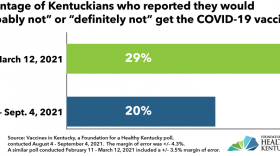The Murray Calloway County Chamber of Commerce annual chamber breakfast went virtual this year and included a look back on how Murray-Calloway County Hospital and the community have been impacted by COVID-19. Murray-Calloway County Hospital CEO Jerry Penner addressed the group of local business leaders and gave a timeline of how the virus affected hospital operations. He also gave vaccine information and an outline of how they will be distributed in the community over the next year.
Penner said the hospital began making preparations in early spring, including installing UV Air Scrubbing in the HVAC system and creating a “negative pressure” floor which would become the COVID ward. He said the hospital saw a lot of nursing staff leave during the beginning of the pandemic; these were nurses considered high risk for COVID and the threat of the virus coaxed them into early retirement. Penner said this problem was not unique to Murray-Calloway County Hospital and soon many hospitals in the region were clambering to hire more nursing staff as the pandemic ramped up.
“That was tough, and every single hospital in this area was fighting for nursing staff and are continuing to fight for nursing staff,” Penner said. “Typically, our nursing staff gets paid anywhere between $20 and $30 an hour and agency staff zoomed up to as high as $77 an hour and topped out at over $200 an hour to try to get an agency nurse to the hospital.”
Penner praised nursing staff and others for working long hours and “continuing to do great work on the COVID floor.”
Penner noted Calloway County had among the highest rates of COVID-19 infections in the entire region. He said this started to ramp up in June along with the hospital’s oxygen utilization.
But October through the present is what Penner refers to as “the real deal” when it comes to the effects of COVID-19.
“We’ve been absolutely overrun by the amount of patients,” he said. “To give you an example of our oxygen requirements, typically I would refill our oxygen supply once a month, we were down refilling our oxygen cylinders every three to four days.”

The hospital’s emergency room has also been hit hard by COVID-19. Penner said the hospital usually admits around 10% of patients that come into the ER, but by December that number was up to 20%. He said the ER only has 12 rooms, and each room has to “air out” for 45 minutes after a person experiencing COVID symptoms uses it. Afterward, the rigorous cleaning process takes another 45 minutes, creating long wait times for an already overwhelmed ER. Penner said COVID-19 patients are also pushing the average hospital stay from around four-and-a-half days to eight.
Penner said antibody treatments called “Monoclonal Antibody Therapy” were game changers. He said the goal of this treatment was to keep COVID patients from being admitted to the hospital. He said the hospital offers Bamlanivimab and Regeneron to patients who are at high risk of developing severe COVID-19 symptoms and are early in their diagnosis.
Looking forward to vaccine distribution, Penner said he expects an uptick in vaccinations in February. He said Kentucky is expecting to receive around 62,000 doses of the vaccine per week, that’s up from about 56,000 per week in January. Penner said Executive Adviser for the Kentucky Cabinet for Health and Family Services Mark Carter told attendees of Murray State’s virtual Town and Gown event this week that it could take up to 40 weeks to get vaccines to 2.4 million Kentucians.
“I know all of you just did your quick math and said, ‘Wait that’s in November, Jerry,’ and you are right, that’s a long, long time,” Penner said. “But it’s going to become more fast and furious as we begin to unleash more and more of the vaccine to the community.”
Murray-Calloway County Hospital received the Moderna vaccine and gave 700 doses to hospital staff, according to Penner. He said it’s a common concern that the vaccine will make a patient sick, but said the side-effects are not any worse than a flu shot. He said the hospital staff that experienced side effects reported soreness, a knot at the inoculation site, a low fever and chills. He said in one extreme case, a worker reported nausea and vomiting. Because of the mild side-effects, Penner suggested local business leaders stagger their employees' vaccinations and leave room for sick days.
Penner said Calloway County has requested to be a vaccination site along with 1,100 other sites across the state. Because of the high amount of requests, Penner said it is uncertain whether Calloway County will be chosen.
“If we get tapped, it’s a great thing for our community, but don’t be surprised if we don’t,” he said.
Penner said even though local health departments and some hospitals are making vaccination lists, individuals in the community shouldn’t don’t assume they will receive the vaccine until an appointment is made. He said these lists are important because they show how many people who are at-risk need to be vaccinated. In Calloway County, Penner said the health department has determined around 3,000 people over the age of 70 need the vaccine.




